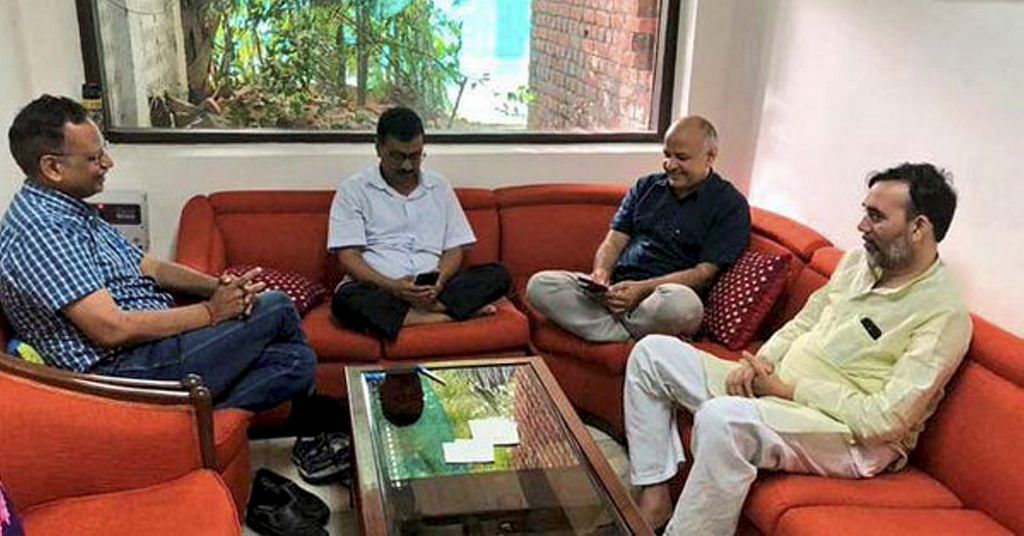The capital transformed under a Congress government in Delhi and an NDA government at the centre. But, Kejriwal is not Sheila Dikshit and Modi is not Vajpayee.
Delhi chief minister Arvind Kejriwal has got his politics wrong. Not because babus in the Delhi government are paragons of virtue. Not because Lieutenant Governor Anil Baijal listens to His Master’s Voice any less than his predecessor. And, also not because the Aam Aadmi Party (AAP) leader is holding the sit-in in the air-conditioned waiting room of the Raj Niwas, and not on the scorching pavements outside, as he would have done in his activist days to make a spectacle that would have beholden the common man.
There are at least five reasons that make his latest tactic self-defeating. First, people want a leader who leads them and not someone who comes back to them every now and then, whining about the injustice – whether real or perceived – being meted out to him/her. Remember Narendra Modi’s USP or unique selling point in the run up to the 2014 Lok Sabha elections: a strong man with a ‘56-inch chest’ and the panacea for everything afflicting the nation, then under a “weak” prime minister Manmohan Singh. People give their mandate to govern. It’s not their responsibility to teach their chief minister how to deal with political adversaries or a supposedly hostile bureaucracy.
Second, the timing of the CM’s dharna is an affront to the people. At a time when people are being shot at and beaten to death (in Sangam Vihar and Wazirpur) over water in the national capital, a sit-in by the chief minister, his deputy and two other ministers, essentially over powers and jurisdiction, can be anything but sensitive. Air pollution in Delhi has reached a hazardous level, and the CM simply brushes it off, laying the blame on two secretaries who skipped the state environment minister’s meeting to discuss the issue. Is the ruling party of Delhi living up to its name or is it just a misnomer?
Third, the politics behind Kejriwal’s dharna is quite obvious: to cushion the AAP against public backlash for its failures in governance, and to gain relevance in the anti-BJP federal front. The visit of four chief ministers – Mamata Banerjee of West Bengal, Chandrababu Naidu of Andhra Pradesh, Pinarayi Vijayan of Kerala and H.D. Kumaraswamy of Karnataka – to Kejriwal’s residence Saturday to meet his wife Sunita and convey their solidarity with him underscored the obvious. The Congress has been critical of Kejriwal’s sit-in, and the expression of support by these four opposition CMs exposed the fault lines in the mahagathbandhan-in-the-making. But that’s a different story.
Kejriwal is a believer of chitt bhi meri, patt bhi meri (heads I win, tails you lose) tactic. How else could one explain his remarks in an interview to the Hindustan Times Sunday? “Even our opponents believe the AAP government has done a wonderful job, especially in the fields of health, education, power and water. People across the country have started asking that if the AAP government has delivered so much in three years, why can’t the other state governments, where the BJP is in power,…follow suit?” he said. Well, if Kejriwal could achieve so much, as he claims, despite the bureaucracy, why could he not continue his good work now? And, if the bureaucracy was with the civil servant-turned-activist-turned-politician earlier and suddenly turned against him – whoever be the agent provocateur – the fault must be laid at Kejriwal’s door too. The pitfall with such tactic is you assume people are naïve and stupid. But you do it at your own peril.
Fourth, a section of Kejriwal’s supporters see in his dharna a sign of his preparation to launch another movement like the ‘India against Corruption’ of 2011-12 ahead of the 2019 Lok Sabha elections, but the timing may not be right for this. Corruption charges against Prime Minister Narendra Modi or the NDA government have failed to stick. Ask Congress president Rahul Gandhi about his promised earthquake. Besides, such a movement by opposition leaders, most of whom are facing corruption charges, is likely to be a non-starter.
Fifth, Delhiites elected a chief minister to translate activism into governance, and not governance into activism. Kejriwal’s allegations against the NDA government’s interference in Delhi affairs may have some merit, but it can’t be a justification for non-performance. His predecessor, Sheila Dikshit, has criticised his dharna, calling it an “excuse to not work”. She was the chief minister of Delhi for 15 years, the first six of which coincided with Atal Bihari Vajpayee’s tenure as the prime minister. During that period, development projects such as the Delhi Metro and mandatory plying of CNG buses got rolling.
Ask someone who was in Delhi in the 1980s and 1990s. The thought of people hanging out of overcrowded buses on congested roads still brings shivers. The foundation of Delhi’s transformation was laid when there was a Congress government in Delhi and an NDA government at the centre. But, of course, Kejriwal is not Sheila Dikshit and Modi is not Vajpayee.
